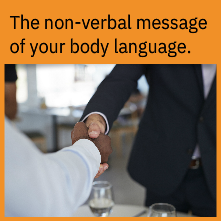When you send messages to others, it’s not just the words that are received. It’s a combination of all three elements: the words you use, your tone and pace, and your body language
Let’s move to the second topic
Being an effective communicator requires more than just finding the right approach for each communication style. You need to ensure that when you speak or write, you communicate as effectively as possible exactly what you want others to understand. It goes without saying that you need to work toward being a better communicator. How can you do this? Mae West was an American actor. How does their quote tie in with communication? When we say the word communication, many people think only of the spoken word. However, there’s paraverbal communication, which is about how you say things; your tone, speed, pitch, and volume. Then there’s nonverbal communication, which is about the gestures and body language that accompany your words. Another type is written communication, which takes place through email or the written word. Whichever way you communicate, you need to make sure the messages you send are clear despite language, culture, time, and place differences.
Use as few words as
possible without impacting the meaning of what you’re conveying. State your
message briefly and clearly by:

- Eliminating unnecessary words. For example, instead of saying “Our
entire team will be implementing this new procedure in the not too distant
future,” say “We’ll implement this procedure soon.”
- Using active voice. For example, instead of saying “Travel will be
reduced due to budget cuts,” say “Budget cuts will reduce travel.”
- Avoiding absolute words. Such words don’t allow any exception. When
you use them too often, people perceive you as critical or judgmental,
which can make the person you’re speaking to feel defensive and stop
listening. For example, instead of saying “You always arrive late,” say
“You often arrive late.”

The tone and pace at which you communicate is how you say something rather than what you say. The way you speak often reflects how you feel. When you feel angry or excited, your speech tends to become rapid and high pitched.
Manage the tone and pace at which you communicate. A hurried pace can make the listener feel anxious and rushed. A slower than normal pace can make the listener feel as though your message is not important. Focus on intonation when you speak. When you’re talking face-to-face, raising or lowering your voice adds emphasis to an idea. Pausing also adds emphasis. In written communication, using

Non-verbal communication plays an important role in the delivery of your message. You want your words, voice, and body language to be consistent with each other. Use these physical cues to add content to your communication. Remember, some of these cues may need to be modified or avoided based on local culture.
- Manage your facial expressions; for example, don’t frown while giving someone a compliment.
- Maintain eye contact.
- When presenting, occasionally move around to other parts of the room or among the audience.
- Avoid doing anything that might distract your audience from the message; for example, using colloquial language, clicking a ball point pen, playing with a marker, and so on.
Use hand gestures appropriately. This one can be particularly tricky; for instance, did you know that the thumbs-up sign is considered offensive in certain cultures